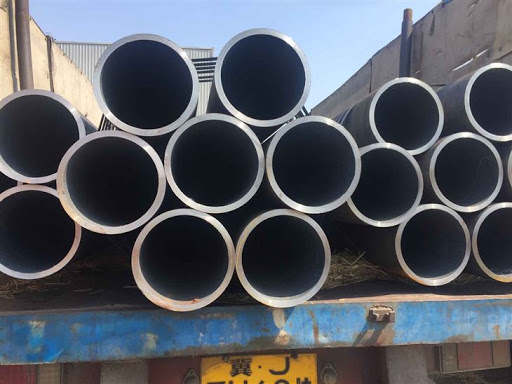High-frequency quenching is mostly used for surface quenching of steel pipes (seamless pipes and welded pipes). It is a metal heat treatment method that generates a certain induction current on the surface of steel pipes, rapidly heats the surface of steel pipes, and then rapidly quenches them. Induction heating equipment, that is, equipment for inductively heating steel pipes for surface quenching.
The principle of induction heating: the steel pipe is placed in the inductor, and the inductor is generally a hollow copper tube that inputs medium frequency or high frequency alternating current (1000-300000Hz or higher). The alternating magnetic field generates an induced current with the same frequency in the steel pipe. The distribution of this induced current in the steel pipe is uneven. It is strong on the surface, but weak inside, and close to zero in the center. Using this skin effect, the surface of the steel pipe can be heated rapidly, and the surface temperature rises to 800-1000°C within a few seconds, while the core temperature rises very little.
Process method of high frequency quenching
Rapid heating combined with immediate quench cooling. The surface of the steel to be processed reaches the quenching temperature by rapid heating. It cools rapidly without waiting for the heat to be transferred to the center, and only the surface layer is hardened to martensite, and the center is still the unquenched original annealed (or normalized and tempered) structure with good plasticity and toughness.

The main method of high frequency quenching
Induction heating surface hardening (high frequency, intermediate frequency, power frequency), flame heating surface hardening, electric contact heating surface hardening, electrolyte heating surface hardening, laser heating surface hardening, electron beam heating surface hardening.
Application of High Frequency Quenching
For steel pipes subjected to alternating loads such as torsion and bending, the surface layer is required to bear higher stress or wear resistance than the core, and the surface of the steel pipe needs to be strengthened, which is suitable for steel with a carbon content of We=0.40~0.50%.
Compared with ordinary heating and quenching
1. The heating speed is extremely fast, which can expand the transformation temperature range of body A and shorten the transformation time.
2. After quenching, the surface layer of the steel pipe can obtain very fine cryptocrystalline martensite, and the hardness is slightly higher (2~3HRC). Less brittle and higher fatigue strength.
3. The workpieces treated by this process are not easy to oxidize and decarburize, and even some steel pipes can be directly assembled and used after treatment.
4. Deep hardening layer, easy to control and operate, easy to realize mechanization and automation.
5. Flame surface heating and quenching
The principle of induction heating: the steel pipe is placed in the inductor, and the inductor is generally a hollow copper tube that inputs medium frequency or high frequency alternating current (1000-300000Hz or higher). The alternating magnetic field generates an induced current with the same frequency in the steel pipe. The distribution of this induced current in the steel pipe is uneven. It is strong on the surface, but weak inside, and close to zero in the center. Using this skin effect, the surface of the steel pipe can be heated rapidly, and the surface temperature rises to 800-1000°C within a few seconds, while the core temperature rises very little.
Process method of high frequency quenching
Rapid heating combined with immediate quench cooling. The surface of the steel to be processed reaches the quenching temperature by rapid heating. It cools rapidly without waiting for the heat to be transferred to the center, and only the surface layer is hardened to martensite, and the center is still the unquenched original annealed (or normalized and tempered) structure with good plasticity and toughness.

The main method of high frequency quenching
Induction heating surface hardening (high frequency, intermediate frequency, power frequency), flame heating surface hardening, electric contact heating surface hardening, electrolyte heating surface hardening, laser heating surface hardening, electron beam heating surface hardening.
Application of High Frequency Quenching
For steel pipes subjected to alternating loads such as torsion and bending, the surface layer is required to bear higher stress or wear resistance than the core, and the surface of the steel pipe needs to be strengthened, which is suitable for steel with a carbon content of We=0.40~0.50%.
Compared with ordinary heating and quenching
1. The heating speed is extremely fast, which can expand the transformation temperature range of body A and shorten the transformation time.
2. After quenching, the surface layer of the steel pipe can obtain very fine cryptocrystalline martensite, and the hardness is slightly higher (2~3HRC). Less brittle and higher fatigue strength.
3. The workpieces treated by this process are not easy to oxidize and decarburize, and even some steel pipes can be directly assembled and used after treatment.
4. Deep hardening layer, easy to control and operate, easy to realize mechanization and automation.
5. Flame surface heating and quenching









